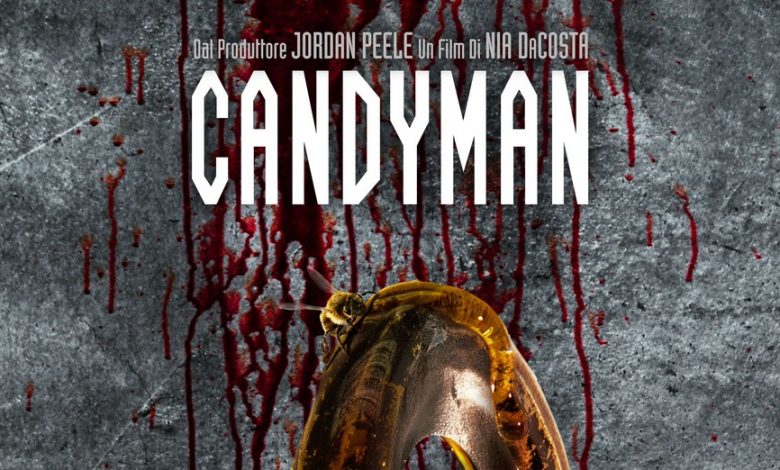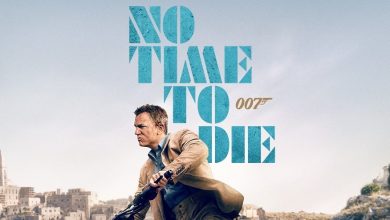Review: Candyman

Score: 3.5/5
Nia DaCosta’s long awaited Candyman works as a stand-alone horror film, though it’s actually a direct sequel to the Bernard Rose-directed 1992 original, in which an imposing Tony Todd played the iconic title character. Although this is technically the fourth in the series, DaCosta’s film ignores the events of Candyman: Farewell to the Flesh (1995) and Candyman: Day of the Dead (1999) (so, Daniel Robitaille didn’t go to New Orleans or stalk a former Baywatch lifeguard? Fine with me). You still need to say his name five times to summon him, though, and some tell-tale bees show up just before things get really bad.
It begins with Sammi Davis Jr.’s classic tune (do I need to say which one?), and it’s the first time this franchise has acknowledged it. We push in on Cabrini-Green in Chicago of 1977, with the traumatic childhood experience of a young boy encountering the Candyman setting things in motion. Once the timeline moves to 2019, we meet Anthony McCoy, played by Yahya Abdul-Mateen II, a promising artist who is struggling to make an impression. After hearing about the title character in the form of an urban legend (which re-tells the events of the original 1992 from a new perspective), McCoy becomes obsessed with the Candyman. Immediately after McCoy’s unveiling of a gallery showing of his Candyman-influenced art, mutilations and unsolved murders start piling up. Is it McCoy, becoming obsessed with the Candyman, the way Virginia Madsen’s Helen Lyle was in the original, or has the Candyman come back?
Mateen II should have become a breakout star for his Emmy-winning performance on the HBO “Watchmen” mini-series and for playing Bobby Seale in The Trial of the Chicago 7. His commanding work here should do the trick- he’s positively captivating here, even as his character becomes hard to like by the second act. Returning from the original is Vanessa Williams, whose single scene cameo has an emotional wallop, and Todd and Madsen make welcome contributions that are so much more than mere cameos.
The screenplay by DaCosta, Win Rosenfeld and Jordan Peele, is more up front about the issues of gentrification, racial tensions, and police brutality in Chicago than the original film ever was, a proper reaction to contemporary times. Occasionally, this can be didactic or too on the nose. Considering the presence of bees in this franchise, it’s clever that the police are referred to here as a “swarm”, but hearing McCoy’s phone hum like a bee or having a character talk about the “buzz” of a career is too much.
At one point, someone states that the Candyman is a reaction to all the racist violence inflicted on black people throughout history. It’s a great idea and the movie should have trusted the audience to make it for themselves. Far stronger is a generalized but potent observation about art made by black artists: “They love what we make, but not us.” It’s a lot for a high-minded slasher movie, though this franchise has always aimed to be provocative about racism, though this new Candyman is more direct than what came before.
Rose’s ’92 film benefited greatly from the strength of the lead performances from Madsen and Kasi Lemmons and the pull of the set-up. In the first act, the imagery of bees swarming around the city and dwelling in their busy hives have a sublime surrealism. Once the film plunges into gore and the innocent murder suspect who cannot prove her innocence, it becomes redundant and punishing. There’s no denying the classic status of Rose’s film, though it paints itself into a narrative corner by the second act and sports a Phillip Glass score that, as lovely as it is, has never felt right for that movie. A touch no one ever mentions is that the ending of Rose’s film sets up a new urban legend with Madsen’s character (it’s a chilling reveal) that none of the sequels ever acknowledged.
The ’95 Candyman: Farewell to the Flesh really misses the center that Madsen and Lemmons brought the first film, as lead Kelly Rowan can’t carry it, leaving it to Todd, the New Orleans setting and some great moments to carry it (like a wild bit where a character weaponizes saying the Candyman’s name five times). It was also an early film for Bill Condon, who would follow it up with Gods and Monsters and Dreamgirls. Condon’s film makes a curious, distasteful choice of having fake-out scares where Rowan or a different white co-star thinks she’s about to see Candyman but, surprise, it’s a different black actor. It’s a dubious way to generate jump scares. On the other hand, Condon’s film depicts a flashback to the racist violence that created the Candyman, and it’s a powerful, shocking scene. There are good things in Condon’s film (Glass’ score, in particular, seems a better fit, or maybe it just grew on me).
The less said about Candyman: Day of the Dead, the better, though I wanted to give it a shot, since Todd was among the producers. It was made cheaply, released straight to video and is total schlock. Todd always makes an impression, even in films like this, but having Donna D’Errico, veteran star of Baywatch and Baywatch Nights, take over as the lead was, to be kind, unsuccessful.
The prior three films were primarily about three white women who learn about systemic racism and brutality towards black men, in which they are essentially tourists into a poverty-stricken, predominately black environment and immerse themselves in history. It’s interesting how the new Candyman is, for the first time, from a black perspective, since the series has always been noted as a rare example of a 90’s horror film dealing with the struggle of African Americans.
Not everything in DiCosta’s film works, as the tight 90-minute running time sports a final act that feels rushed. While every sequence is beautifully shot and performed, the stalk and slash moments are the least effective, because they’re the most familiar. I won’t give anything away, but there’s a talking killer finale that also feels mechanical. The final scenes, which are kind of a sequel set-up but are mostly a full realization of the established themes, are stunning and make up for the proceeding moments.
A major highlight are the hypnotically beautiful and chilling flashbacks sequences, presented via shadow puppets. Keep your eye on any reflective surfaces, as there are jolts that may go unnoticed the first time. There’s also a stunning pullback from an apartment complex, revealing a murder scene from a distance (similar to the scariest sequence in Peele’s Us).
An interesting quality to this franchise is that the main characters are academics, artists, and intellectuals, all of whom are rational but skeptical and in their 20-30’s. The 2021 Candyman is mostly inhabited by driven, highly competitive professional artists, a catty art critic and survivors of the first film. While the film’s satire of the art world is lite, this is more for grownups than a teen slasher audience. It’s this reason why the high school girl’s room sequence (featured prominently in the first trailer) feels out of place; it’s a well-done set piece and succeeds in broadening the film’s appeal beyond the fanbase of the original but would be more appropriate for Freddy Kreuger than the Candyman.
Still, the screenwriters have succeeded in properly replicating the formula, as this takes its time to develop the characters, atmosphere and a steadily increasing, creepy tone. The cinematography, sound design and score (Robert Aiki Aubrey Lowe’s stylish work is unnerving and pays homage to Glass’s theme) are excellent.
The prior Candyman films (particularly the first two) had a premise that was far scarier than the film itself. DiCosta’s Candyman has really haunted me since the first time I saw it. It’s as smart and scary as you’d hope, honors the legacy of what came before it and leaves an eerie aftertaste. The last of the end credits has a website that urges the audience to learn more about “racial justice and healing,” a fitting and most unusual touch for a horror film. The exemplary work of everyone involved has resulted in a resurrection for the long dormant 90’s franchise. This is the best in this series so far.



